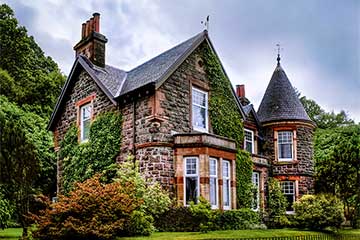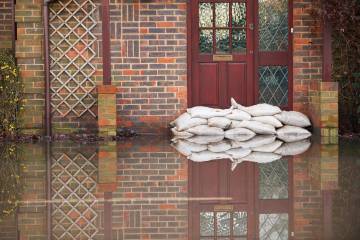- Is more likely to be classed as non-standard and require a specialist insurer
- May use plaster or wattle and daub panelling, which needs specialist skills to repair
- Could be seen as higher risk depending on the materials used. For example, if it has a thatched roof, the house carries a greater risk of fire
-
May lack foundations, putting the house at risk of landslide or subsidence
- May be a listed building - particularly if built before 1850
- Home
- Home insurance
- Timber frame home insurance
Timber-framed home insurance
Timber-framed houses are becoming more popular in the UK as they’re faster to build and more environmentally friendly.
You can still get home insurance for a timber-framed house, but they carry additional risks that can lead to higher insurance costs. Fire, rot and pest damage can all take their toll on the frame. You may also need to look at specialist home insurance for an older or listed property.
Get a home insurance quote now to see what your options are, or read on for everything you need to know about insuring a timber-framed house.

Ready to get a home insurance quote?
Get a quoteHow will having a timber-framed house affect my home insurance?
If you have a timber-framed house you can get home insurance, but you might find that fewer options are available to you or you may have to go through a specialist insurer. You may find your insurance costs are higher, even if you don’t need non-standard home insurance.
This is because timber-framed houses are more susceptible to certain risks than standard brick-built homes, such as fire and rot. Older timber-framed houses often use building materials that are higher risk and more expensive to replace. These houses could also have a thatched roof or may even be a listed building. According to our data*, the annual price of buildings insurance is £480 for a Grade I and £427 for a Grade II listed building.
To make sure your timber-framed house is fully covered, it’s best to be as accurate and detailed as possible when you get your home insurance quote.
*Based on Confused.com data, January - March 2024
Why does the age of my timber-framed home make it harder to insure?
A historic or older property:
A modern property or renovation:
-
Is usually covered by regular home insurance and has a wider range of home insurance providers to choose from
- Tends to use more conventional construction materials, which are cheaper and easier to repair if you need to claim
- Are generally seen as safer than older timber-framed houses because they have to meet modern building standards
-
Can include renovated Tudor homes, barn conversions and some eco-homes
What is wattle and daub panelling and why does it increase my insurance cost?
Wattle and daub panelling is one of the most common infills in older timber-framed buildings. It's made up of small timbers (the wattle) that support a mud-based daub, which is then plastered over with lime plaster or a modern alternative.
On average, a timber-framed house with wattle and daub panelling costs £511* to insure, compared to a timber walled structure which, costs £244*. In comparison, standard brick wall properties cost on average £186* for buildings only cover.
Insurers may quote a higher insurance cost for homes that use wattle and daub because any repairs require specialist techniques. It's also at increased risk of fire and damp. Wattle and daub panels are usually found in old and historic buildings, which come with their own insurance considerations.
There are benefits to wattle and daub panelling, though. It's not as rigid as traditional modern infills, so they can better withstand structural movements that might weaken a more fixed structure. It also provides better insulation than brick and its structure allows moisture to evaporate faster.
*Based on Confused.com data, January - March 2024
What risks are associated with timber-framed houses?
Insuring a timber frame house is usually more expensive than a standard home or buildings insurance policy because there are greater risks associated with it.
Your home insurance costs are likely to be higher because timber frame houses are:
- At greater risk of fire
-
More susceptible to flood damage as the frame can rot
- Vulnerable to rot even in the absence of flooding
- Liable to develop dry rot due to fungal growth in the frame
- At risk of pest infestation from beetles and other insects
How can I lower the cost of insuring my timber-framed house?
You can help keep the cost of timber-framed home insurance down by staying on top of household maintenance. Keeping your home in good condition helps prevent issues that increase the risk of you making claim on your policy.
- Avoid delaying any necessary repairs and deal with issues in good time
- Ensure good ventilation and watch out for any condensation or leaks that could encourage damp
- Regularly check your woodwork for signs of rot, which could attract pests.
- In increased temperatures look out for dry rot, which needs expert treatment
- Install safety systems to compensate for the increased risk of your timber frame home, such as fire extinguishers, alarms and sprinkler systems
How do I get a home insurance quote for a timber frame house?
You normally need to give more detail to get a home insurance quote for a timber-framed house than you would to get one for insuring a standard home.
Find out the history of your home before you start your quote to make sure you get the right cover. You need to know:
-
Whether your house has wattle and daub panelling
-
Whether it has a thatched roof
-
Whether it has foundations
-
Whether it’s a listed building
-
What state of repair it’s in
-
Whether there are any signs of subsidence
Will home insurance cover my log cabin?
Log cabins can sometimes be classed as timber framed homes.
You should be able to find home insurance for your log cabin as long as it has a permanent address. If it doesn’t, you need non-standard home insurance.
While they may need specialist cover, a key advantage of mobile log cabins is that they don’t need planning permission.
If you’re renting out your log cabin as a holiday home, you should also consider guest house insurance.
Types of home insurance
Flat insurance
can be tailored to cover the building, content or both depending on whether you own or rent your flat.
Flat roof insurance
find home insurance for your flat or partially flat roofed property.
Thatched roof insurance
protects your thatched roof home against theft, loss and damage.
Flood insurance
can offer some protection for your home and belongings if you live in a flood risk area.
Over 50s home insurance
can provide peace of mind your home and belongings are protected against loss, damage and theft.
Non standard insurance
get cover for your non-standard home. Protect your belongings against theft, loss and damage.
What our home insurance expert says
Home insurance guides

100+ Private rental market statistics 2024
We’ve collated the latest private rental market statistics for 2024, covering topics including average price, rental affordability, and tenant satisfaction.

UK Home insurance statistics 2023
Our collection of UK home insurance statistics for 2023, such as average UK home insurance costs, UK home insurance market share and property insurance claim statistics.

When was my house built? Find your property's age
The age of your property could impact how much you pay for your home insurance. Here's how you find out how old your house is.

Flood Re - all you need to know
Living in a high-risk flood area can come with high insurance costs - that's why the Flood Re Scheme was created. Here's how you work out if you're eligible.

Smart home technology: Will it impact your home insurance?
Smart homes are on the rise, but will you be safer in a connected home? Here's how smart home technology might impact your home insurance.

Insurance for electric bikes explained
Electric bike insurance covers you against damage and theft of your ebike. You should be able to add it to your home insurance policy.
